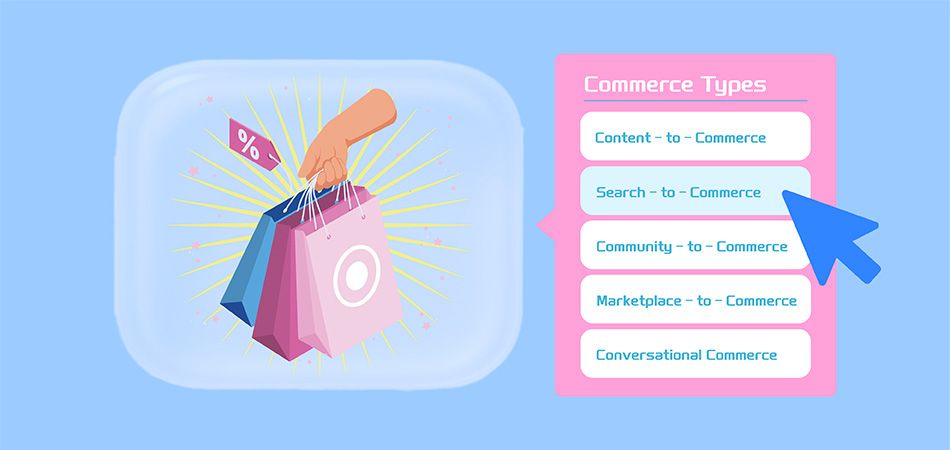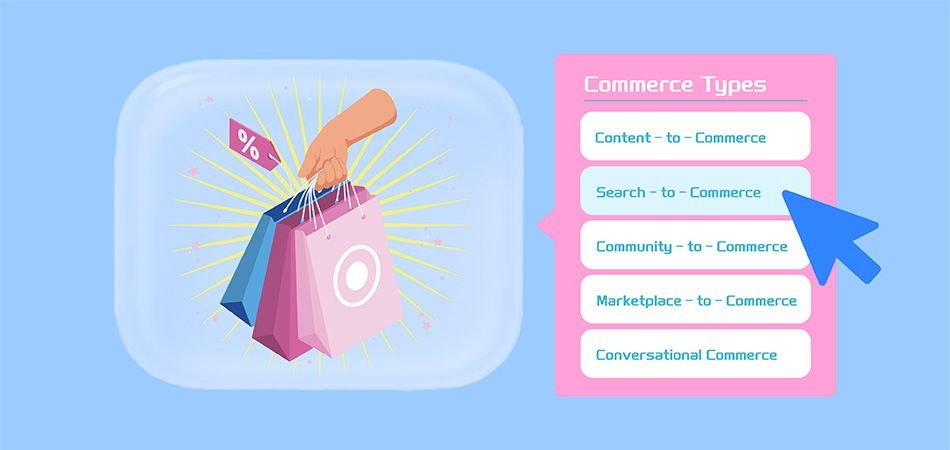
If you’re still building your dropshipping strategy around B2B, B2C, or DTC, you’re working with outdated tools.
These traditional labels no longer reflect how people discover, evaluate, and buy products in 2025—especially in a world of TikTok virality, community selling, and AI-powered conversations.
What really matters now isn’t who you sell to, but how you convert.
In this guide, we’ll break down five modern commerce types that match how buyers actually behave—and how smart dropshippers are turning them into real profits.
1. Content-to-Commerce: Turning Views into Buyers
Before we dive into the specific types of modern commerce that are reshaping how dropshippers operate, let’s start with the most attention-driven and trend-powered model of them all: Content-to-Commerce.
|
|
Get Started Now to Grow Your Online Business with the Best AliExpress Dropshipping Tool – DSers! |
What is Content-to-Commerce?
Content-to-Commerce refers to a sales model where engaging content—usually short-form video or social media posts—is the starting point of the customer journey. Instead of waiting for customers to search for a product, you bring the product to them through content they’re already consuming.
Platforms like TikTok, Instagram Reels, and YouTube Shorts have made this model mainstream. A single viral video can generate thousands of visits—and purchases—within hours.
Why It’s a Game-Changer for Dropshippers
Dropshippers thrive on speed, trend leverage, and low upfront cost. Content-to-Commerce fits perfectly because:
- It’s organic-first: You don’t need to rely on expensive ad budgets. Creative, low-cost videos can bring massive traffic.
- It’s product-led: Great for visually appealing or problem-solving products—like massage guns, mini printers, or portable blenders.
- It’s scalable: One piece of content can be repurposed across channels and reused in ads, email flows, and landing pages.
- It builds curiosity and trust: Real-life use, reactions, and storytelling drive engagement far better than static product pages.
This is especially powerful for trending or impulse-buy products—the kind that dropshippers often sell.
How to Apply It to Dropshipping (Step-by-Step)
Step 1: Choose a Content-Friendly Product
- Pick items with clear visual impact or demonstration potential.
- Think “TikTok-worthy”: satisfying use, before-after effect, surprise factor.
Step 2: Script with a Hook → Problem → Resolution Flow
- Example: “I didn’t think this $20 neck massager would work—until I tried it…”
- Keep the content short (15–30s), authentic, and relatable.
Step 3: Use Shoppable Links and Smart CTAs
- Add product links in bios, captions, or integrated TikTok Shops.
- Use calls-to-action like “Watch till the end” or “Link in bio to grab yours.”
Step 4: Track What Converts
- Monitor which videos lead to traffic or orders using UTM parameters or TikTok Pixel.
- Reuse top-performing content as ad creatives later.
Dropshipper Tip 💡
No time to film? Work with micro-influencers or use UGC platforms to get low-cost, rights-cleared content you can use immediately. Tools like Billo, Breef, or Collabstr are great starting points.
Why It Works Now—And Will Keep Working
Consumers are increasingly discovery-led. They don’t search for what they want—they scroll until something stops them. Content-to-Commerce allows you to intercept attention, tell a story, and create demand on the spot. And with TikTok Shops and Instagram Checkout evolving fast, this funnel is only getting shorter—and more powerful.
2. Search-to-Commerce: Attracting Ready-to-Buy Customers
Before you even realize it, someone is already Googling the exact product you’re selling—right now. Unlike social content that creates demand, Search-to-Commerce captures people with intent. These are users actively looking for a solution, and if your product page shows up at the right moment, you’re just one click away from a sale.
 |
Insightful Guide to Start Dropshipping
An ebook with all key points to start a dropshipping business that is sustainable and profitable in 2024 |
What is Search-to-Commerce?
Search-to-Commerce refers to a buying journey that starts with a specific query typed into a search bar and ends with a transaction. Unlike passive scrolling, this model taps into high-intent behavior, making it one of the most efficient ways to drive warm traffic to your store.
For dropshippers, it’s less about going viral and more about being visible at the exact moment of need.
Why It’s Powerful for Dropshippers
Search-based traffic often converts better, costs less to maintain over time, and works especially well for:
- Functional or solution-based products: Anything that solves a clear, immediate problem
- Evergreen categories: Health, home improvement, pet accessories, productivity tools
- SEO-savvy niches: Where long-tail keywords still have relatively low competition
Here’s what makes it uniquely effective:
- Intent-first traffic: People aren’t just curious—they want to solve a problem or buy now
- Lower bounce rate: SEO-optimized content answers a need and encourages action
- Sustainable: Once ranked, organic traffic can compound over time
- Highly targeted: You can optimize by device, location, question type, and even buyer stage
How to Apply It to Dropshipping (Step-by-Step)
Step 1: Find Long-Tail, Problem-Solving Keywords
Use keyword research tools such as Google Keyword Planner, Ubersuggest, or AnswerThePublic to discover relevant long-tail phrases. Focus on specific intent-driven phrases like:
- “How to organize desk cables”
- “Quiet desk fans for home office”
- “EDC tool for opening boxes”
Step 2: Create Search-Friendly Product Pages or Blog Posts
Optimize your pages with:
- Keyword-rich product titles & meta descriptions
- Real use cases and benefits above the fold
- Internal linking to related content or FAQs
- Alt text on images + schema markup if possible
Step 3: Use YouTube & Pinterest for Visual Search Power
Repurpose product demonstrations or UGC into:
- YouTube Shorts with “How to…” titles
- Pinterest Pins linking back to your store
These platforms act as long-term visual search engines and drive consistent traffic.
Step 4: Monitor Rankings & Refine
Track performance with Google Search Console, Ahrefs, or SurferSEO. Update content regularly based on CTR, bounce rate, and keyword position.
Dropshipper Tip 💡
Pair Search-to-Commerce with retargeting ads. When someone visits your SEO page but doesn’t buy, show them the product again later on Facebook or TikTok with a time-limited offer.
Why It Works Now—And Will Keep Working
As AI reshapes how people interact with search engines—through tools like ChatGPT Browse, Google’s SGE, and voice search—intent-based discovery will only become more structured and relevant. By building a solid SEO foundation now, you position your store to ride the next wave of organic demand—even as search evolves beyond just keywords.
3. Community-to-Commerce: Monetize Trust, Not Just Traffic
You’ve heard it before: people buy from people they trust. But in 2025, that trust isn’t built through ads—it’s built through community. Community-to-Commerce is about creating a space where people share interests, exchange value, and organically engage with your brand before they ever click “Buy.”
For dropshippers, especially those building niche brands, this model turns one-time buyers into long-term fans—and fans into advocates.
What is Community-to-Commerce?
Community-to-Commerce refers to the model where purchases emerge naturally from ongoing social interaction, shared identity, or value-based relationships. This might happen in a private Discord server, a Facebook Group, a WhatsApp broadcast list, or even a niche subreddit.
Instead of cold traffic, you’re building warm conversations around products people actually care about.
Why It’s a Hidden Gem for Dropshippers
While most dropshippers chase traffic spikes, community builders focus on retention, word-of-mouth, and recurring sales. Here’s why this model works:
- It reduces acquisition cost: Engaged communities become self-sustaining traffic sources
- It boosts customer lifetime value (CLTV): Loyal members are more likely to buy again—and refer others
- It allows for direct feedback: New product ideas, customer pain points, content topics—all from the source
- It creates defensibility: Unlike ads or marketplaces, your community is hard to copy or compete with
How to Apply It to Dropshipping (Step-by-Step)
Step 1: Choose a Community Platform That Matches Your Niche
- FB Groups: Still strong for lifestyle, parenting, beauty, and wellness
- Discord: Ideal for tech, EDC, gaming, or hobby-based products
- Telegram/WhatsApp: Great for deals, restocks, and broadcast-style engagement
Step 2: Offer Value Before You Sell
- Share product tips, lifestyle content, behind-the-scenes updates
- Run polls, challenges, and early access drops to increase participation
- Invite UGC: ask members to post how they use your product, then spotlight them
Step 3: Use Commerce Touchpoints Naturally
- Pin product links in FAQs or community guides
- Offer members-only discounts or bundles
- Create urgency around drops, pre-orders, or stock alerts
Step 4: Nurture Your Core Advocates
- Identify your top 5–10 most active members
- Offer them affiliate links, early products to test, or feature their stories
- Turn them into micro-influencers for your brand
Dropshipper Tip 💡
Start small. A tight-knit group of 50 engaged users is more valuable than 5,000 passive followers. Use your thank-you page or post-purchase email to invite new customers into your community right after their first order.
Why It Works Now—And Will Keep Working
In a landscape overwhelmed by generic ads and AI-generated content, authenticity and shared experience are becoming the new currency. Gen Z and Gen Alpha buyers are far more likely to trust what’s recommended by peers, not paid media. By investing in community now, you’re building long-term equity that paid channels simply can’t buy.
4. Marketplace-to-Commerce: Leverage Big Platforms Wisely
Amazon, Etsy, eBay—they’re not the enemy. But they’re also not the goal.
For many dropshippers, marketplaces feel like a shortcut to instant sales. While they do offer traffic and trust by default, relying solely on them can quickly become a trap: thinner margins, brutal competition, and a race to the bottom. Marketplace-to-Commerce is about using these platforms strategically—not as your business, but as your springboard.
What is Marketplace-to-Commerce?
This model involves leveraging established platforms (like Amazon, Etsy, or even Walmart Marketplace) to build early traction, validate products, and gain reviews—then converting that attention into your owned channels, such as your Shopify store, email list, or community.
Think of marketplaces as your front porch—not your entire house.
Why It’s a Smart Play for Dropshippers
Used the right way, marketplaces offer some undeniable advantages:
- Built-in traffic and trust: Buyers already trust Amazon’s checkout and reviews
- Rapid product testing: You can validate price points and demand with low friction
- Lower CAC (customer acquisition cost): No need to spend upfront on ads or SEO
- Social proof builder: Positive reviews fuel credibility across all channels
But it’s important to avoid over-reliance. Marketplace policies change often, fees add up, and customer data usually isn’t yours.
How to Apply It to Dropshipping (Step-by-Step)
Step 1: Identify Products Marketplace Shoppers Already Search For
Use** Amazon Suggest**, Etsy Search, or tools like Helium 10 or EverBee to find high-search, low-competition products in your niche.
Step 2: Optimize Listings Like Landing Pages
- Use strong product titles with benefits, not just specs
- Add lifestyle images or UGC where allowed
- Include a strong product story in bullet points and description
Step 3: Cross-Promote to Owned Channels Subtly (But Legally)
- Insert QR codes in packaging that link to your website or community
- Offer exclusive discounts for direct purchases via inserts or follow-up emails (where permitted)
- Use post-purchase flows to invite customers into your SMS list or WhatsApp group
Step 4: Know When to Exit or Scale Off-Marketplace
Once you’ve validated demand and built up reviews, move your bestsellers to your branded store, where you control margins, design, and customer data.
Dropshipper Tip 💡
Use marketplaces to discover breakout products. If one item starts outselling others, build a brand story around it and redirect attention to your own platform, where you can scale with bundles, upsells, and loyalty offers.
Why It Works Now—And Will Keep Working
As competition on ad platforms grows and privacy restrictions tighten, marketplaces remain one of the few predictable traffic sources for early growth. But the real leverage lies in owning the relationship—not just the sale. The most successful dropshippers in 2025 use marketplaces to build momentum, not dependency.
5. Conversational Commerce: Selling Through Chat & AI
The future of ecommerce is not just about websites or ads—it’s about real conversations. Whether through chatbots, live messaging, or AI assistants, Conversational Commerce is transforming how dropshippers connect, engage, and convert customers in 2025.
What is Conversational Commerce?
Conversational Commerce means selling products through direct, interactive conversations. This can happen via:
- Chat apps like WhatsApp, Facebook Messenger, or WeChat
- AI-powered chatbots that answer questions and guide buyers
- Voice assistants like Alexa or Google Assistant
Instead of pushing products at customers, you’re having two-way conversations that build trust and personalize the shopping experience.
Why Dropshippers Should Care
- Higher conversion rates: Personalized recommendations through chat increase buyer confidence
- Instant customer service: Quick answers reduce cart abandonment and boost satisfaction
- Automated upsells & cross-sells: AI can suggest related products during chats
- Accessible anywhere: Mobile-first communication meets customers where they spend most time
With privacy concerns rising and cookies fading, conversations provide a direct, consent-based line to your customers.
How to Start Using Conversational Commerce (Step-by-Step)
Step 1: Choose Your Platforms
Pick the chat apps your target audience uses most—WhatsApp for global reach, Messenger for Facebook users, or Telegram for niche groups.
Step 2: Set Up Chatbots or AI Assistants
Use tools like ManyChat, Chatfuel, or Tidio to automate FAQs, product recommendations, and order tracking.
Step 3: Personalize Your Conversations
Segment customers by behavior and preferences. Tailor your messages and offers based on browsing history or purchase data.
Step 4: Train Your Team for Live Chat
For complex queries or upselling, live agents or yourself should step in seamlessly from chatbot to human.
Step 5: Use Conversational Ads and Click-to-Chat
Run ads that lead directly to chats or add “Click to Chat” buttons on your website and social media for instant interaction.
Dropshipper Tip 💡
Leverage conversational commerce to turn browsers into loyal customers by creating engaging, helpful chats—not just sales pitches. Use AI chatbots to qualify leads and hand over warm prospects to humans at the right time.
Why Conversational Commerce Is a Game-Changer
With AI rapidly improving, chat-based commerce offers personalized, scalable, and direct customer interaction like never before. Dropshippers who master this will stand out by building real relationships, boosting lifetime value, and thriving despite rising ad costs and privacy challenges.
6. Hybrid Strategy: Combine Commerce Types for Maximum ROI
There’s no one-size-fits-all approach in dropshipping. The strongest brands combine different commerce types to maximize traffic, conversions, and profits.
Why Choose a Hybrid Strategy?
- Diversify Risk: If one channel slows, others keep sales flowing
- Expand Reach: Different customers respond to different platforms
- Optimize Profitability: Balance high-margin owned stores with volume from marketplaces
Real-World Hybrid Examples
| Hybrid Model | Description | Benefits |
|---|---|---|
| Content + Community | Use TikTok videos to attract, then a private group to engage loyal fans | Builds trust & repeat buyers |
| SEO + Conversational Commerce | Rank on Google, then guide visitors to WhatsApp chats for personalized help | Higher conversion & satisfaction |
| Marketplace + Owned Store + Email | Start on Amazon for reviews, then move buyers to your Shopify store and nurture with emails | Control margin & customer data |
How to Pick Your Hybrid Model
Consider three key factors:
- Traffic Source: Where does your audience spend time?
- Margin Structure: High-margin suits content/owned stores; low-margin fits marketplaces.
- Niche Type: Community-driven niches vs. price-driven vs. convenience-focused.
Mix and match commerce types to build flexible, resilient funnels that maximize ROI and future-proof your dropshipping business.
Conclusion
Dropshipping in 2025 is all about smart choices and flexibility. Use content, marketplaces, chat, or any mix that fits your niche and customers.
Don’t rely on just one channel—combine strategies to grow faster, sell more, and keep your margins healthy.
Start today: test, learn, and scale what works. The ecommerce winners will be those who act fast and adapt even faster.
Your dropshipping success depends on taking action now. Let’s get started!
This articles is written by : Nermeen Nabil Khear Abdelmalak
All rights reserved to : USAGOLDMIES . www.usagoldmines.com
You can Enjoy surfing our website categories and read more content in many fields you may like .
Why USAGoldMines ?
USAGoldMines is a comprehensive website offering the latest in financial, crypto, and technical news. With specialized sections for each category, it provides readers with up-to-date market insights, investment trends, and technological advancements, making it a valuable resource for investors and enthusiasts in the fast-paced financial world.

